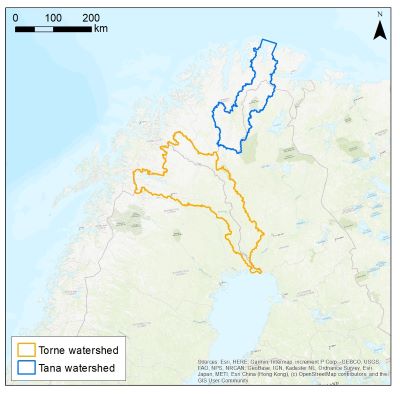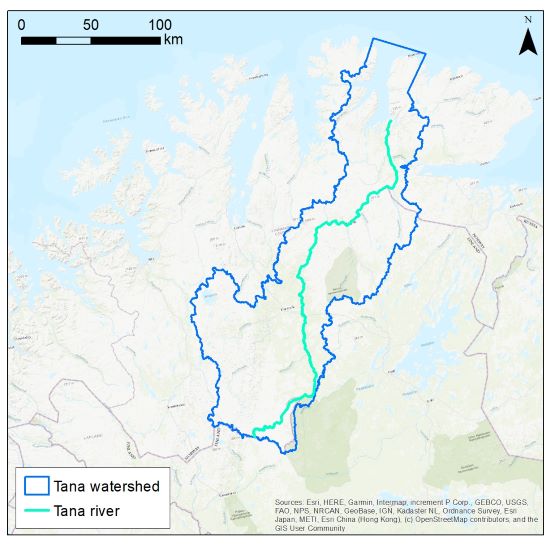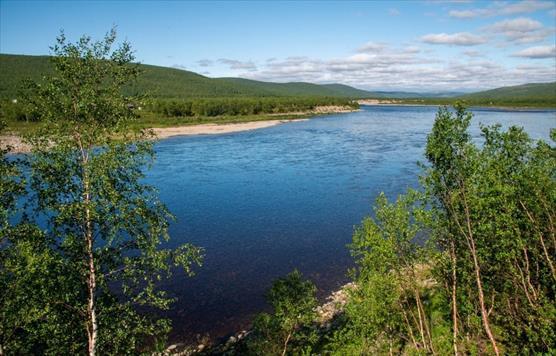
Study areas of the BARIMS project
The BARIMS project, that is funded by the Finnish Ministry for Foreign Affairs, aims to enhance regional co-operation in the light of sustainable development and safeguarding biodiversity in the Barents Euro-Arctic Region. In the project areas that are significant for biodiversity will be studied, and means for safeguarding nature values and ecosystem functions as a part of mitigation of and adaptation to climate change will discussed.
In the project the possibilities to evaluate nature values of large river catchment areas and bordering marine areas and effects of climate change to the ecosystems will be studied. A project is implemented in two stages: in 2020-2021 and 2022-2023.
The main activities in the BARIMS project are in 2020-2023
- To compile existing spatial data on selected catchment areas and bordering marine areas, that are significant for biodiversity.
- To find means to evaluate the effects of climate change to the nature values, ecosystems and use of nature resources of the selected catchment areas.
- To identify main actions, that need to be taken for safeguarding biodiversity and nature-based economics in the Barents Euro-Arctic Region.
- To produce interactive information on effects of climate change on biodiversity.
Study areas
BARIMS project focuses studying two transboundary areas in the Barents Region: Finnish-Swedish Torne River catchment area and Finnish-Norwegian Tana River catchment area.
Torne River catchment area
The over 500 km long river starts near the Norwegian border in Sweden’s Norrbotten County, and flows southeast until it together with Muonio River, which joins with Torne River from the north, starts defining the border between Sweden and Finland. From there it flows south into the northernmost part of the Bothnian Bay. The Torne River catchment area crosses into Finnish Lapland, but roughly 65% of the area is situated in Sweden.
The northern parts of the catchment area are characterized by heath- and moorland and fells. There are instances of deciduous trees in the north, with the forest landscape becoming more a mix of deciduous and coniferous forests towards the south. Wetlands are also very common in the area. Torne River is valuable migratory fish river, where salmon, sea trout and whitefish have spawning sites.
Reindeer husbandry is practiced extensively in the area by Sami, and the area is part of the Sami cultural region. Generally, the area is sparsely populated, with the largest populations found in the Swedish Kiruna (population ~23 000) and Finnish Tornio (population ~21,000).
Tenojoki catchment area
The Tenojoki catchment area is located partly in Finnmark county in Norway, and partly in northern Lapland in Finland. The spesific character of Teno watershed area is that it belongs biogeographical on three different zones. The southernmost zone in Utsjoki area and in adjacent Finnmark area belong to Fell Lapland zone, which is part of the Northern boreal forest zone and Fell Birch is there dominant tree, which in general describes oceanic pattern in vegetation. But this zone is rather continental, with cold winter. Some permafrost and palsa mires also occur in the area.

Teno river catchment area has several protected areas, e.g. Øvre Anárjohka National Park, Kevon Strict Nature Reserve, ja Kaldoaivi Strict Nature Reserve.
North of Fell Lapland area occur zone named, Fjord Lapland, that reaches to the ends of fjords. It is a clearly oceanic northern boreal zone, where fell birch is the dominating tree species, but also forest plants Geraniun sylvaticum and Cornus suecica are common. The last zone close the open sea is named as true hemiarctic zone and it is highly oceanic and almost treeless. Sea is open year-round. Many plant species occuring in this zone are Arctic.

Tana River valley is one of the Finnish national landscapes. Photo Riku Lumiaro.
Contact information
Development Manager Kirsi Kostamo, Finnish Environment Institute SYKE, etunimi.sukunimi@syke.fi, puh. +358 295 251 315
Read more